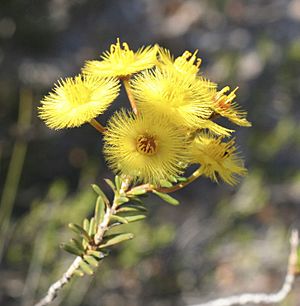Verticordia laciniata facts for kids
Quick facts for kids Verticordia laciniata |
|
|---|---|
 |
|
| Verticordia laciniata growing near the Hill River | |
| Scientific classification | |
| Genus: |
Verticordia
|
| Species: |
laciniata
|
Verticordia laciniata is a beautiful flowering plant that belongs to the myrtle family, called Myrtaceae. This special plant only grows in the south-west part of Western Australia. It's a bushy plant with many branches. Its leaves are long and a bit hairy. The flowers are bright yellow and smell nice. As they get older, they change color to red, then a pretty bronze.
Contents
What This Plant Looks Like
Verticordia laciniata is a shrub that grows with open branches. It can reach a height of about 0.3 to 1 meter (1 to 3 feet). It spreads out to be about 15 to 60 centimeters (6 to 24 inches) wide.
- The leaves are long and thin.
- They are a bit rounded when you look at them from the side.
- Each leaf is about 8 to 20 millimeters (0.3 to 0.8 inches) long.
- They are covered with short, soft hairs.
The Flowers
The flowers of this plant have a lovely scent. They grow in clusters at the ends of the branches. Each flower sits on its own straight stalk, which is about 10 to 16 millimeters (0.4 to 0.6 inches) long.
- The sepals (small leaf-like parts under the petals) are bright yellow. They are about 4 millimeters (0.16 inches) long and have 11 or 12 feathery edges.
- The petals are about 3 to 4 millimeters (0.12 to 0.16 inches) long. They are shaped like an egg or are almost round.
- The petals have deep cuts or lobes, making them look fancy.
- When they first bloom, the petals are bright yellow. But as they get older, they turn red.
- The style (a part of the flower's reproductive system) is about 5 millimeters (0.2 inches) long. It is straight or slightly curved and smooth.
- This plant usually blooms from September to October.
How This Plant Got Its Name
The plant Verticordia laciniata was first officially described in 1991. A scientist named Alex George wrote about it after finding samples near Walkaway. His description was published in a science journal called Nuytsia.
The second part of its name, laciniata, comes from a Latin word, lacinia. This word means "the fringe or edge of a piece of clothing." This name was chosen because of the fringed, or feathery, parts of the flower called staminodes.
Where This Plant Grows
This type of verticordia plant likes to grow in sandy soil, loam (a mix of sand, silt, and clay), and clay. You can often find it growing with other kinds of verticordia plants in areas with heath (low-growing shrubs) and shrubland.
It lives in a specific area of Western Australia. This area stretches between Walkaway, the Coomallo Important Bird Area, Three Springs, and Coorow. These places are part of the Avon Wheatbelt and Geraldton Sandplains regions.
Protecting This Plant
The Western Australian Government's Department of Parks and Wildlife has looked at Verticordia laciniata. They have officially said that it is "Not Threatened." This means there are enough of these plants, and they are not currently in danger of disappearing.
Growing This Plant in Gardens
People who love gardening describe this verticordia as "a beautiful slender or bushy shrub with brilliant honey-perfumed flowers." It sounds wonderful, but it can be quite tricky to grow. Only a few of these plants have successfully been grown in home gardens.
- Gardeners usually try to grow it from cuttings (small pieces of the plant).
- The plants that have managed to grow well seem to prefer a sunny spot in the garden.

